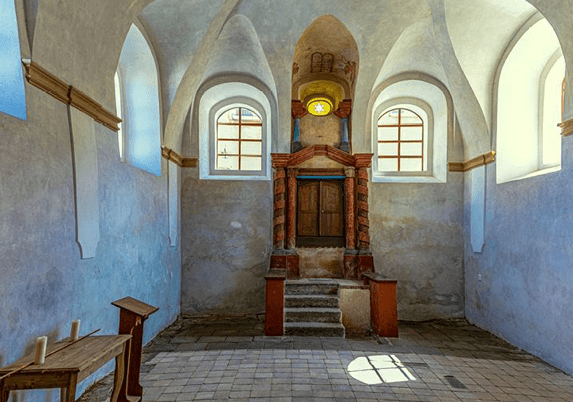March 18, 2021 by Rabbi Jeffrey Cohen
Read on for article
Book Review: Rabbi Jeffrey Cohen reviews Light beyond the Shadows: The Legacy of the Czech Torah Scrolls by Sheila Pallay and Julius Muller.

When this book first arrived, I looked at it with a little trepidation. This looked like one of those nice coffee table books one purchases when attending an exhibition at an Art Gallery. And yet I knew that it was about the work of the Memorial Scrolls Trust based at Westminster Synagogue [which is not far from Westminster Abbey and Westminster Cathedral].
I knew about the Scrolls Trust as my Dean when I was a rabbinical student was also the rabbi of Westminster Synagogue. I had preached once in the Synagogue and as a student rabbi took my Sunday school students to visit. The building alone is quite magnificent. It is a Victorian-style building which actually a century-plus before had been, for a short time, the residence of the Duke of Kent and his mistress. It became a synagogue at the end of the 1950s when a group broke away from the West London Synagogue in support of their rabbi, Harold Reinhart.
The story of the scrolls itself is one of intrigue. In 1962 the Israeli government had tried to negotiate with the Czech government to acquire the scrolls which were stored in a warehouse which itself had previously been the Michle synagogue. It fell to a London-based philanthropist, Ralph Yablon, to successfully negotiate for their relocation to London in February 1964. The total number of scrolls acquired was 1564, most of which have been distributed around the world (including a number in Australia) and about 150 remain at the Westminster Synagogue. In 1988 a Museum was established on the site and contains a wonderful collection of Torah decorations including wimples (Torah binders), Torah covers as well as breastplates and Torah bells and crowns. To visit one needs to make an appointment which can be done on their web site.
In the 1960s a wandering sofer/scribe knocked on the doors of Westminster Synagogue. His name was David Brand, He would go from synagogue to synagogue asking if they had any scrolls that needed checking and perhaps some repairs. My Dean told the story that they asked him in, sat him down, and then told him the size of the task. He moved his family to London and was there decades later.
The book is only about towns that are in the modern Czech Republic. It focuses on 33 towns although there is a map of Czech Torah Scroll Collection Points and Towns Nearby which shows far more dots on the map. Knowing that Czech was spoken beyond the political borders of the country the authors still chose to limit the study to the current Czech Republic.
One of the disagreements about this story is whether the Nazis intended to create a Museum to the Final Solution. It was a story I heard until 1990 when the current director of the Prague Jewish Museum emphatically informed me that while the story had existed for decades there was no evidence in any of the archives of such a plan.
Returning to the book. To say the photographs by Sheila Palley are spectacular is to not do them justice. The book seems about 75% photographs. They are basically grouped around towns which once had a Jewish community. In most cases, they show the building in the town, which was once the synagogue, as well as other significant pieces.
More harrowing but perhaps even more important were the many photographs and notes about how many of the towns had memorialized that time when madness ruled the world. Some communities have restored the buildings which once housed the synagogues even when no Jews currently reside there.
There are a number of one-page items, one or two extending to two. Each of the authors explains their motivation for the book. The chair of the Trust tells a little about the Trust. There is a profile of the current sofer. There is a piece by the latest young person from the community who became a rabbi last year, having studied at the Geiger (Rabbinical) School in Berlin and the University of Potsdam.
When I was working with the St. Louis Holocaust Center and Museum, we designed a program for one Yom Hashoah. There were seven Westminster scrolls in the community. The program was in a synagogue. The Ark had all the synagogues’ scrolls removed. As each of the seven scrolls was brought in to be placed in the Ark a reader told the story of that scroll as well as the community from which it came.
The Scrolls Memorial Trust has a website which lists every synagogue in the world [which so chooses] to connect their website to the Trust and most also tell the story, when possible, of the particular Jewish community from which they came. It has been suggested to do something similar in Australia but so far it has not happened. You may wish to look at your synagogue’s website to see if you have one. A few synagogues have scrolls that survived the Shoah but are not part of the Westminster Scrolls collection. Those scrolls, too, should be listed on the synagogues’ websites
Don’t be fooled by the coffee table appearance of the book. It subtly recounts the horrors of the time. It could be read in conjunction with another book designed for Primary School aged children called the Tattooed Torah which is also available at the trust’s bookstore [https://mstshop.org/].
Published by Memorial Scrolls Trust 2020 £ 18
 RSS Feed
RSS Feed















 March 18th, 2021
March 18th, 2021  Awake Goy
Awake Goy  Posted in
Posted in  Tags:
Tags: 













